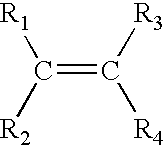Coating composition including a water-based copolymer cross-linking with a water-dispersible cross-linking agent, method of preparing the same, and a cured film thereof
a cross-linking agent and coating composition technology, applied in the direction of coatings, liquid surface applicators, pretreated surfaces, etc., can solve the problems of poor chip performance and environmental acid etching of cross-linking between water-based copolymers of the prior art, and achieve low cost, stable viscosity, and improved chip resistance
- Summary
- Abstract
- Description
- Claims
- Application Information
AI Technical Summary
Benefits of technology
Problems solved by technology
Method used
Image
Examples
examples
[0079]The first block of the copolymer was prepared by adding and reacting the following parts, by weight, unless otherwise indicated.
[0080]
TABLE 1HydroxylCarbonateCarbamateFunctional GroupEx. 1Ex. 2Ex. 3First BlockAmountAmountAmountReactant(grams)(grams)(grams)Acrylic acid67.967.967.9Hydroxyethl methacrylate61.200Carbonate-modified glycidyl0.087.687.6methacrylateMethyl methacrylate61.261.261.2Diphenylethylene10.010.010.0Ammonia66.166.166.1 +(25% solution of ammonia in water)32.0Ammonium persulfate15.015.015.0DI water400.4400.4400.4% Non-Volatile32.9%35.1%34.6%
[0081]The addition of the various components to form the first block of the copolymer will only be described in terms of Example 1 having the hydroxyl functional group in the first block. Unless otherwise indicated, a person of ordinary skill in the art is to assume that the various components for forming the first block in Examples 2 and 3 are to be added in the same manner.
[0082]Per the above table, Table 1, 350.4 grams of d...
PUM
| Property | Measurement | Unit |
|---|---|---|
| particle size | aaaaa | aaaaa |
| temperature | aaaaa | aaaaa |
| temperature | aaaaa | aaaaa |
Abstract
Description
Claims
Application Information
 Login to View More
Login to View More - R&D
- Intellectual Property
- Life Sciences
- Materials
- Tech Scout
- Unparalleled Data Quality
- Higher Quality Content
- 60% Fewer Hallucinations
Browse by: Latest US Patents, China's latest patents, Technical Efficacy Thesaurus, Application Domain, Technology Topic, Popular Technical Reports.
© 2025 PatSnap. All rights reserved.Legal|Privacy policy|Modern Slavery Act Transparency Statement|Sitemap|About US| Contact US: help@patsnap.com



